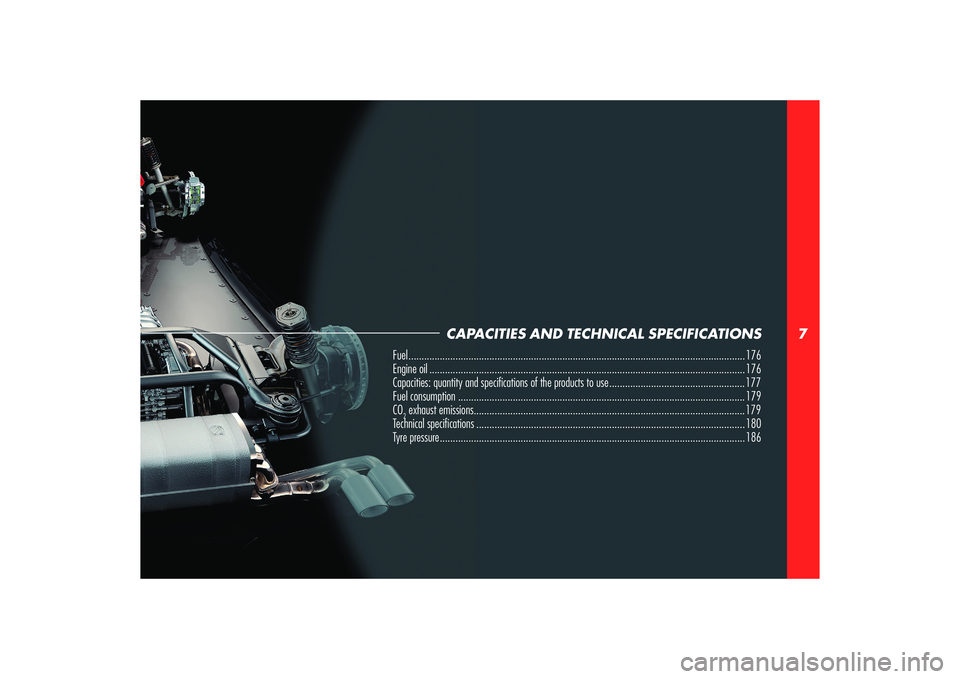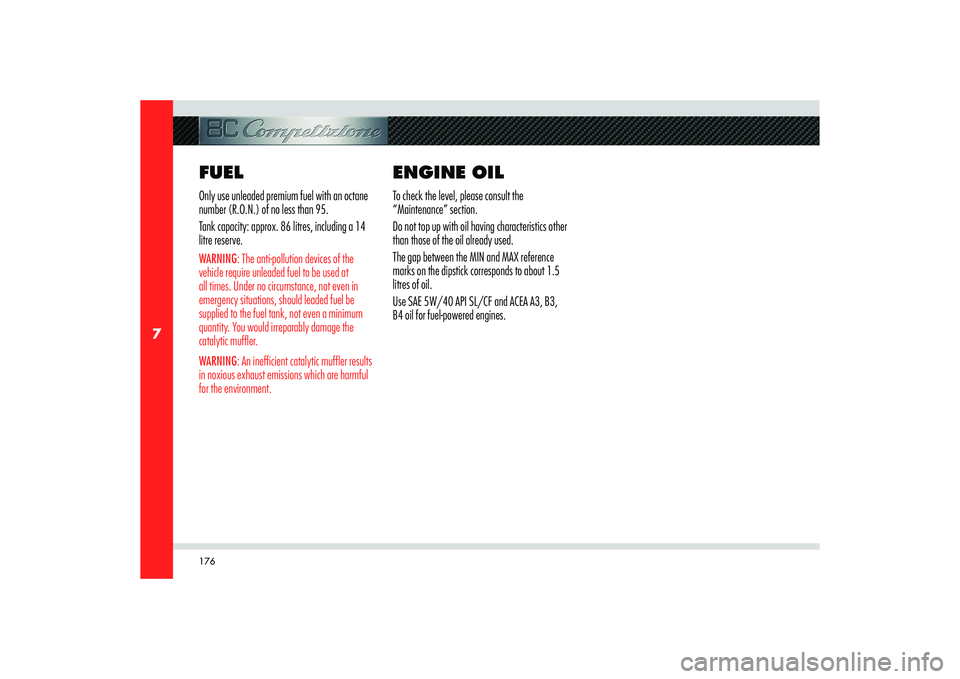Alfa Romeo 8C 2007 Owner handbook (in English)
Manufacturer: ALFA ROMEO, Model Year: 2007, Model line: 8C, Model: Alfa Romeo 8C 2007Pages: 223, PDF Size: 14.35 MB
Page 171 of 223

169
6
IN AN EMERGENCY
CAUTION
The fluid contained in the
battery is poisonous and corrosive.
Avoid contact with the skin and eyes.
The battery recharging procedure
must be carried out in a ventilated
environment away from open flames
or possible sources of sparks: risk of
explosion and fire!
IF YOU HAVE
TO JACK UP THE
VEHICLE
If you need to jack up the vehicle, position the
rubber bushings in correspondence to the arrows.
Page 172 of 223

170
6
IF YOU HAVE TO
TOW THE VEHICLE If you need to tow the vehicle, observe the
following recommendations:
- if possible, have the vehicle transported on
a vehicle equipped with loading platform
and specifi c for roadside assistance and
recovery.
If this is not possible:
- Tow the vehicle for a stretch of less than
100 km at a speed below 60 km/h, using
the towing hook provided in the toolkit.To be able to tow the vehicle, you must:
- Turn the ignition key to MAR without
starting the engine (see page 87)
- Engage neutral (position N) by
simultaneously pulling the gearshift paddles
UP and DOWN while holding the brake
pedal depressed (see page 118)
- turn the key back to position STOP.
CAUTION
Do not extract the key, as the
steering wheel will lock automatically
and you will be unable to steer the
wheels.
CAUTION
When towing the vehicle, make
sure that you observe the road traffic
regulations concerning both the towing
device and driving conduct.CAUTION
When towing the vehicle with
the engine off, remember that, without
the assistance of the brake servo, a
stronger effort is required on the brake
pedal for braking and on the steering
wheel for steering.
CAUTION
Screw down the towing hook
into its seat (approx. 11 turns).
Accurately clean the threaded seat
before tightening the hook.
WARNING: If you have to tow the vehicle with 2
wheels raised, ensure that the ignition key is in
the STOP position. Otherwise, when the VDC is
active, the relative ECU will store a malfunction,
which will cause the illumination of the warning
light
on the instrument panel display. This
requires the intervention of an Authorised
Service Centre of the Manufacturer’s Network
to correct the system malfunction.
Page 173 of 223

171
6
IN AN EMERGENCY
IN THE EVENT OF
AN ACCIDENT It is important always to stay calm.
- If you are not directly involved, stop at a
distance of at least ten metres away from
the accident area.
- If you are on a highway, stop without
obstructing the emergency lane.
- Turn off the engine and turn on the hazard
warning lights.
- At night, illuminate the accident area with
the headlights.
- Always act with caution: you should not risk
someone crashing into you.
- Indicate that an accident has occurred
by placing the emergency triangle in a
well visible position and at the prescribed
distance.
- Call the emergency services, providing as
much information as possible. On highways,
use the special emergency call boxes.
- Remove the ignition key from the vehicles
involved.
- If you smell fuel or other chemical products,
do not smoke and ask people around you to put their cigarettes out.
To extinguish fires, even small ones, use a fire
extinguisher, blankets, sand or earth. Never use
water.
In multiple accidents occurred on highways,
particularly where visibility is poor, there is a
high risk of being involved in other collisions.
Leave your vehicle immediately and move away
from it. IF THERE ARE INJURED
PERSONS
- Never leave an injured person alone.
Persons not directly involved in the accident
are also required to give assistance.
- Do not crowd around injured persons.
- Reassure the injured person that aids are on
the way and stay close to them to help with
possible panic attacks.
- Unfasten or cut the seat belts restraining
the injured persons.
- Do not give the injured persons anything to
drink.
- The injured person should never be moved.
- Remove the injured person from the vehicle
only if there is a risk of fi re, sinking in water
or falling down into a pit. When removing
an injured person, do not pull his/her limbs,
bend his/her head and, as far as possible,
keep the body in a horizontal position.
Page 174 of 223

172
6
FIRST AID KIT
Housed inside the luggage compartment, this kit
contains the following:
- sterile gauze to cover and clean the wounds
- bandages of various size
- treated adhesive bandages of various sizes
- an adhesive bandage strip
- a pack of cotton wool
- a bottle of disinfectant
- a packet of paper cleaning tissues
- a pair of rounded-end scissors
- tweezers
- two haemostatic loops.
The first-aid kit is provided with vehicles to
be used in markets where these items are
mandatory.
Page 175 of 223

6
Page 176 of 223

7VEHICLE IDENTIFICATION DATA
ACTIVE AND PASSIVE SAFETY
INSTRUMENTS AND CONTROLS
BEFORE YOU DRIVE
USING THE VEHICLE
IN AN EMERGENCY
CAPACITIES AND TECHNICAL SPECIFICATIONS
MAINTENANCE
TABLE OF CONTENTS
Page 177 of 223

7
CAPACITIES AND TECHNICAL SPECIFICATIONS
Fuel ................................................................................................................................. 176
Engine oil ......................................................................................................................... 176
Capacities: quantity and specifi cations of the products to use .................................................... 177
Fuel consumption ..............................................................................................................179
CO2 exhaust emissions ........................................................................................................ 179
Technical specifi cations ....................................................................................................... 180
Tyre pressure ..................................................................................................................... 186
Page 178 of 223

176
7
FUELOnly use unleaded premium fuel with an octane
number (R.O.N.) of no less than 95.
Tank capacity: approx. 86 litres, including a 14
litre reserve.WARNING: The anti-pollution devices of the
vehicle require unleaded fuel to be used at
all times. Under no circumstance, not even in
emergency situations, should leaded fuel be
supplied to the fuel tank, not even a minimum
quantity. You would irreparably damage the
catalytic muffler.
WARNING: An inefficient catalytic muffler results
in noxious exhaust emissions which are harmful
for the environment.
ENGINE OILTo check the level, please consult the
“Maintenance” section.
Do not top up with oil having characteristics other
than those of the oil already used.
The gap between the MIN and MAX reference
marks on the dipstick corresponds to about 1.5
litres of oil.
Use SAE 5W/40 API SL/CF and ACEA A3, B3,
B4 oil for fuel-powered engines.
Page 179 of 223

177
7
CAPACITIES AND TECHNICAL SPECIFICATIONS
CAPACITIES: QUANTITY AND SPECIFICATIONS OF THE
PRODUCTS TO USECAPACITIES AND RECOMMENDED PRODUCTS(*) For periodical replacement as provided for by the Maintenance Schedule or for any topping-up, contact the Authorised Service Centres of the Manufacturer’s Service Network to
have the proper products used. Parts to be refi lled Quantity Product specifi cations
Fuel tank
(including low fuel sector) approximately 86 litres Premium unleaded fuel with no less than 95 R.O.N.
Fuel reserve approximately 14 litres
Engine oil: Entirely synthetic multigrade lubricants SAE 5W/40 that meet API SL/CF and ACEA
A3, B3, B4 specifications.
- replace at regular intervals 9.0 litres Recommended oil: Selenia Motor Oil(*).
- top up from the MIN to the MAX
level1.5 litres
WARNING: Do not top up with oil whose specifications differ from those of the oil
already used in the engine.
WARNING: Engine oil consumption depends on the driving style and the conditions in
which the vehicle is used.
Windscreen/headlight washer fluid
tank6.5 litres Mix of water and detergent fluid, in the proportions indicated on the product package.
Detergent fluid: Mix of CUNA NC 956-II surfactants and alcohols.
Recommended fluid: TUTELA PROFESSIONAL SC 35 - Contractual Technical.
Reference No. F201.D02
WARNING: If the temperature is below –20°C, use pure detergent fluid.
Page 180 of 223

178
7
Parts to be refi lled Quantity Product specifi cations
Engine cooling circuit 12.5 litres Mix of water and coolant, in the proportions indicated on the product package.
Coolant: inhibited monoethylene glycol-based protective fluid with anti-freezing
action: CUNA NC 956-16.
Recommended fluid: PARAFLU UP - Contractual Technical - Reference No. F101.M01
Hydraulic power steering - Oil type: ATF DEXRON II D LEV, SAE 10W.
Oil Type ATF Type A - MB 236.2 - ZF ML09/12
Recommended oil: TUTELA GI/A - Contractual Technical - Reference No. F002.B92
Gearbox 2.7 litres SAE 75W/90 above API GL4-GL5C API MT1-PG2 specifications
Recommended oil: TUTELA SPORT ZC SUPREME
“Q-Select” system ~0.5 litres Oil type: CHF
Recommended oil: TUTELA GI/R - Contractual Technical - Reference No. F428.H04
Braking system - Synthetic fluid: NHTSA n.116 DOT4, ISO 4925, SAE J1703 J1704, CUNA NC
956-01.
SAE J1703, FMVSS No. 116 DOT 4 and ISO 4925
Recommended fluid: TUTELA TOP 4 - Contractual Technical - Reference No. F001.A93
Air conditioning coolant 600 g R134a
Air conditioning compressor oil 200 cc
(+20/-10 ml)Type RL - 897 SAE J2297/98/99